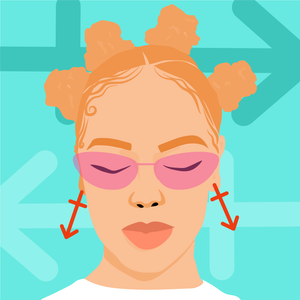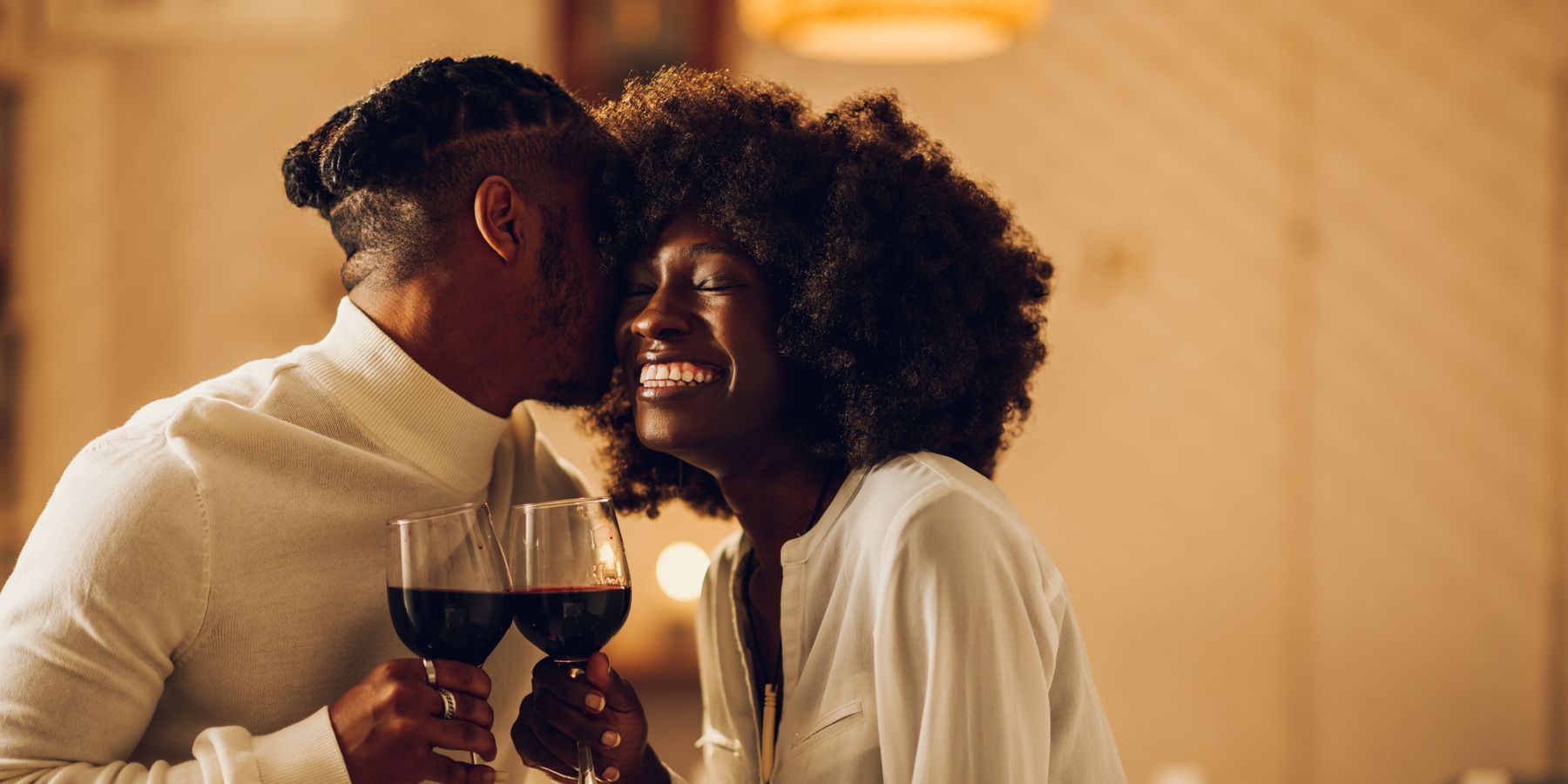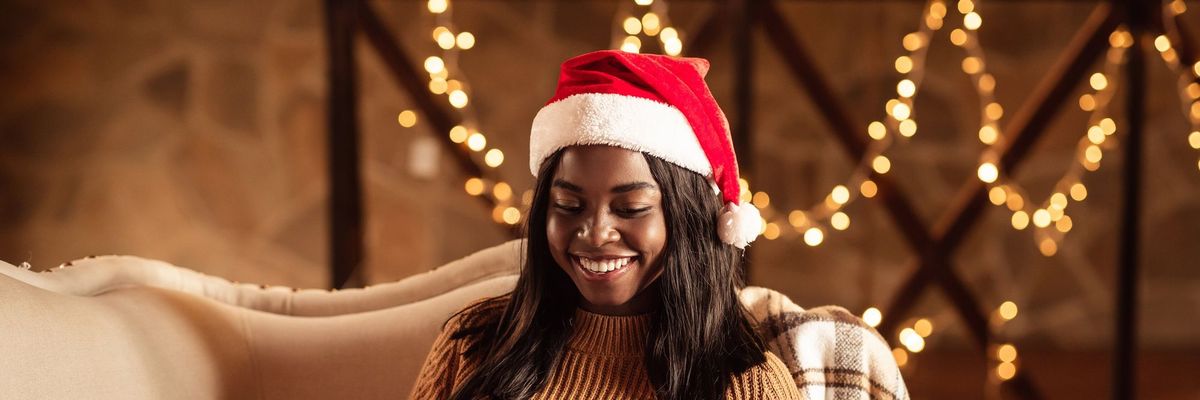Halle Bailey Recently Spoke About Her Postpartum Depression — And I’m So Glad She Did

If you’re one to track celebrity news — which, let’s be real, is oftentimes nothing more than gossip — you’ve probably noticed that actor and singer Halle Bailey’s name has been coming up quite a bit as of late. Last week, she announced a mini solo residency (her first) that sold out in a matter of minutes, and since she and artist DDG (the father of her firstborn son, Halo) have broken up, it’s like folks are publishing minute-by-minute updates on what co-parenting is like for the both of them (and between them).
However, what caught and held my attention was her sharing the fact that she has been going through postpartum depression in the midst of…it all.
As Halle went on to explain her extreme anxiety when it came to being apart from her baby for more than 30 minutes, looking in the mirror and not really recognizing herself, and feeling triggered (in ways she probably wouldn’t be otherwise) — as a doula (which is basically a birthing assistant) who has had a front seat to clients who’ve battled with postpartum depression as well (and also as someone who knows that somewhere around 1 in 8 women deal with it on some level), I thought that now would be as good of a time as any to address some things about postpartum depression head on.
One, so that it can be taken more seriously than it oftentimes is. Two, so that you can know what to potentially look out for if you’re pregnant or someone you care about is. And, last but not least, if you have recently been diagnosed with postpartum depression, you can know that there is absolutely nothing to feel ashamed about — and that you are certainly not alone.
Postpartum Depression. Revisited.
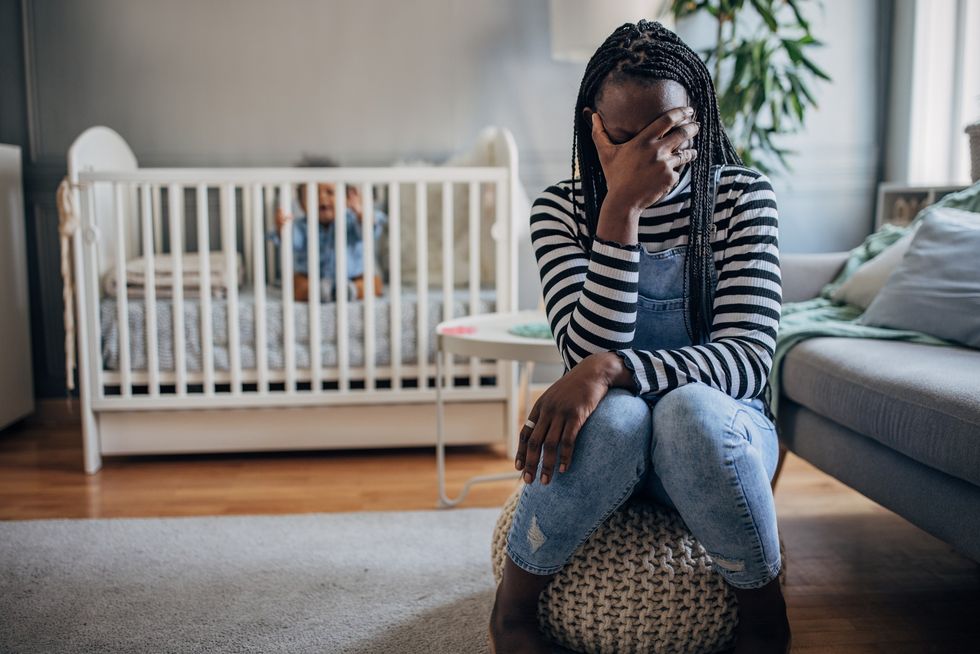
Getty Images
First up, I’m not even gonna begin to act like I can cover something as…vast as postpartum depression in one article. However, I am going to try to provide a bit of fact-based intel, just so you can separate myths, rumors, and the attitude of dismissiveness from what this type of depression is actually all about.
Postpartum depression (which is sometimes also referred to as perinatal depression and is also known as PPD) is the type of depression that occurs either during a woman’s pregnancy or shortly after she gives birth. Although the Greek philosopher and physician Hippocrates spotted emotional challenges that new moms would experience all the way back in his day (which was a LONG time ago), it actually wasn’t until — check it — 1994 (just 30 years ago — SMDH) that the Diagnostic and Statistical Manual of Mental Disorders formally listed postpartum depression “medically defined concept.”
Since then, even more studies have been trying to get to the root of postpartum depression. For instance, a UCLA team came to the conclusion about a decade ago that pregnancy alters the brain on many different levels. It does this by (for example) causing neurosteroid chemicals to skyrocket during pregnancy and then plummet after giving birth, which can cause the brain to go through extremes in order to resume some sort of balance.
In 2019, in response to this, the FDA approved Zulresso (brexanolone). New moms 15 and over can take it, although it absolutely must be under the supervision of a medical professional due to some of its potential side effects.
It also should go on record that there are three different types of postpartum depression — there’s the “baby blues” that easily at least half (some reports say as much as 75 percent) of new moms go through which is pretty (self-) manageable; there’s postpartum depression that comes with more severe symptoms (more on that in a sec), and then there’s postpartum psychosis which is the most extreme kind of PPD. Around 1 in 1,000 women are diagnosed with it, and it can include paranoia, hallucinations, and mania.
Okay, so how can you know if what you are experiencing is “baby blues” or something more serious? That is an excellent question.
5 Early Signs of Postpartum Depression
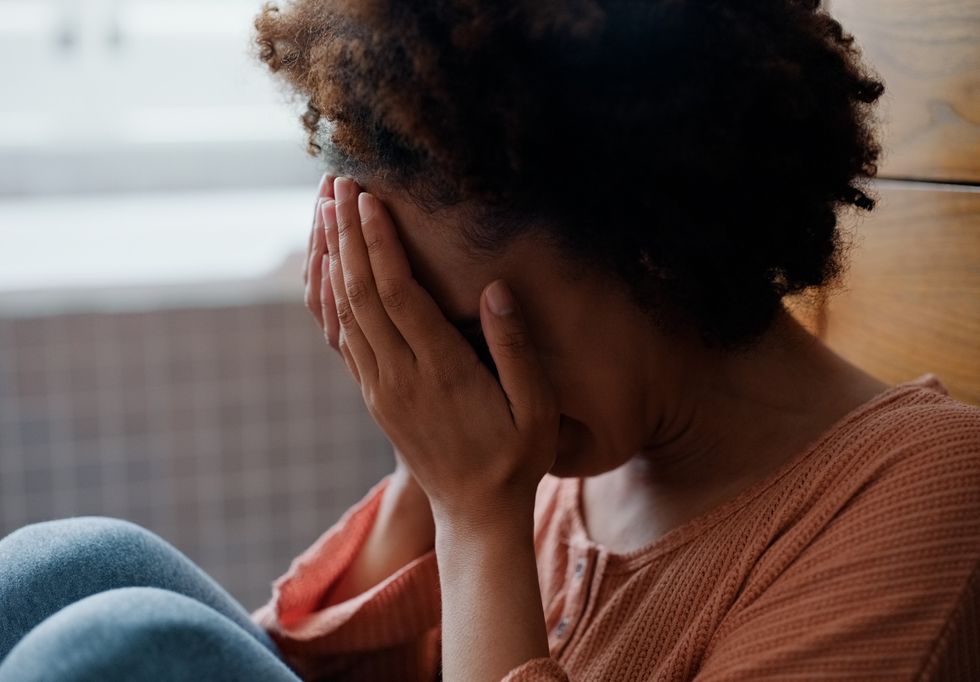
Getty Images
Although some of my clients are individuals who I didn’t know prior to their pregnancy, some people have been friends. One friend, in particular, I had known for about 20 years at the time that I helped her give birth to her first child ,and so I knew her personality very well. That’s why, when I noticed some of the signs that I’m about to share, I alerted her midwife ASAP.
Initially, her midwife said that we should wait a couple of weeks to see if it really was postpartum depression, yet my friend was moving so out of character that I wouldn’t let up. Later on, her midwife told me that she was glad that I didn’t wait because my friend ended up going through a pretty serious bout of postpartum depression for a few months.
1. Early signs of PPD: Your emotions don't "level out" within the first couple of weeks.
Listen, if premenstrual syndrome (PMS) is real (and it is), in part due to all of the hormonal changes that we go through (perimenopause comes to mind, too), I bet you can just imagine all that is going on, hormonally, after giving birth. And while the first couple of weeks can seem a bit all over the place, if you’re not starting to feel like your old self within a couple of weeks or so, don’t merely shrug that off; it could be a postpartum depression warning sign.
2. Early signs of PPD: Your anxiety is through the roof.
Something that really let me know that something was up with my friend is she was obsessed with feeding her child (a part of the issue was mastitis, which is an infection within a woman’s breast tissue). It was so much to the point that she wouldn’t sleep, and when I would be insistent upon it, she would put a bottle up on a pregnancy pillow and prop her baby up next to it (keep in mind that this was a newborn). She was super anxious and irritable, which can be another warning sign of entering into postpartum depression.
3. Early signs of PPD: Your day-to-day patterns are drastically shifting.
Your baby is going to create a new normal for your life; that is guaranteed. However, if you’re noticing that you are totally deviating from everything that you typically do as far as your daily routine goes, while this could be the case for the first few weeks, pay close attention to if it remains that way for longer periods of time. This can be tied to short-term memory loss or feeling very disoriented — another telling sign.
4. Early signs of PPD: You are beyond exhausted.
I once read that new parents tend to lose somewhere around three hours of sleep each and every night during the first year of their child’s life (chile) — and yes, that is going to lead to feeling tired, drained…weary even. Oh, but the exhaustion that I’m speaking of here is when you are well past feeling like you are running on fumes.
Depression exhaustion is when your brain is foggy, your focus is off, and you start leaning into feeling like you’re just existing instead of living because that’s just how worn out you are — and when you can’t seem to find relief, no matter how hard you try, that’s when it could teeter into depression if you’re not careful.
5. Early signs of PPD: You're either overly concerned with or totally detached from your child.
If you can’t think about anything but your baby or you don’t really feel much of an attachment at all, both of these can be signs of postpartum depression setting in as well. While science is still trying to figure out if shifts in oxytocin play a role, it is clear that changes in estrogen, progesterone, and within your thyroid can lead to either outcome — and both aren’t what’s ideal when you have a baby.
5 Signs of Full-Blown Postpartum Depression
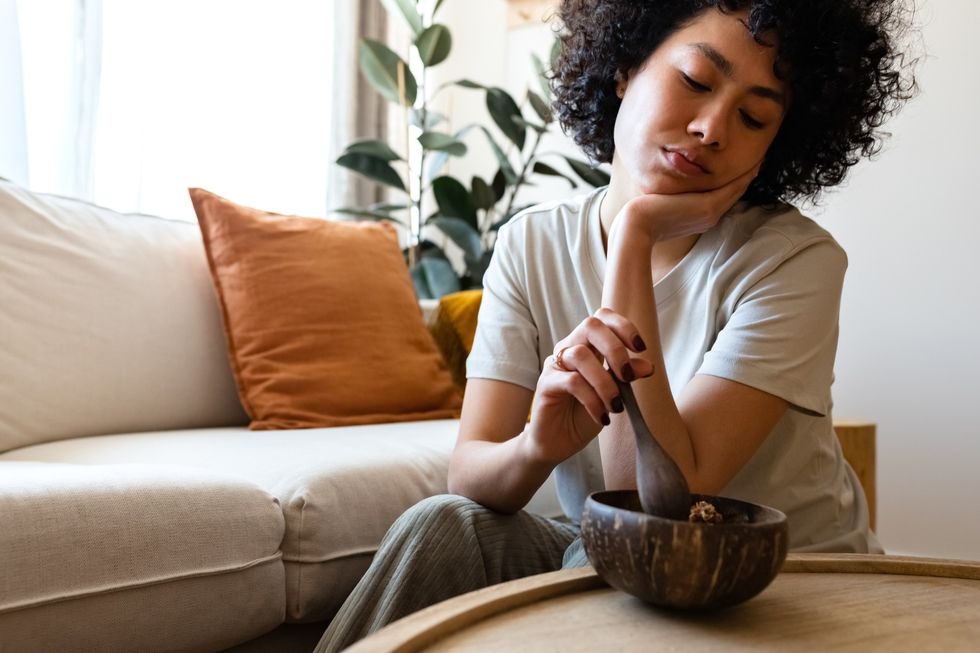
Getty Images
To be honest, everything that I just said can be a warning sign or a clear indication that you are in postpartum depression. The reason why I separated them from the ones that we are about to discuss is that if you only have one of what I just said, it may not be depression; however, if you’ve got three or more of them going on, definitely contact your doctor or midwife, just as soon as you possibly can — especially if they are compounded by these too.
1. Signs of PPD: Loss of appetite
When you’re depressed, it can sometimes cause you to not want to do basic things like showering or eating. A part of this may be due to something known as anhedonia, which is basically the ability to enjoy pleasurable things like food. Thing is, though, in order for you to get your strength back and for your baby to receive the nutrients that they need (if you are breastfeeding), you’ve got to eat. Besides, not eating can lower your blood sugar levels and that can impact your moods.
2. Signs of PPD: Insomnia
It probably doesn’t surprise you that, reportedly, 75 percent of people who are depressed struggle with getting a good night’s rest. The hamster wheel that it can put you on is wild, too, because you initially may struggle with sleeping because you are anxious or worrying a lot, which can have your emotions so all over the place to the point that you need sleep to regulate them…which you can’t seem to get because, again, you’re worrying so much.
There’s no way around the fact that a lack of sleep and depression are linked, so if you’re going days without at least getting some naps in, that could be a sign that postpartum depression has set in. (By the way, lemon balm is something that you might want to try if you can’t seem to sleep and you’re looking for an all-natural way to deal with it.)
3. Signs of PPD: Non-stop crying
If you ever get around to reading TIME’s “The Science of Crying,” you’ll get that nothing about crying is black and white. And honestly, if you’re crying from time to time after having a baby, that is completely understandable — encouraged even because it can help to reduce stress and pain; in fact, it’s pretty damn therapeutic.
What you shouldn’t overlook is if you’re experiencing crying spells to the point where it feels like you can’t stop. That can be an indication of depression because what you are expressing is feelings of hopelessness on some level.
4. Signs of PPD: Suicidal ideations
At the top of this year, Healthline published, “People with Perinatal or Postpartum Depression Face Higher Suicide Risk.” Hormones play a role in this. So does suppressing emotions if you feel some sort of guilt or shame for even having those thoughts during such a special time in your life. Then, if you add to the fact that reportedly only 15 percent of women seek professional mental health support for postpartum depression — sometimes it all can become so overwhelming that ending one’s life seems like the only way out. IT’S NOT.
If you’re thinking about suicide, even just a little bit, please speak up. Again, there’s nothing to be ashamed of; you simply need some expert assistance to get you through it.
5. Signs of PPD: Thoughts of hurting your child.
If it gets to the point where you are considering harming your child, that leans into the psychosis level of postpartum. Still, if a woman is going through all of the signs that I just mentioned, simultaneously, imagine how defeated she must feel. Anyway, although this isn’t the most common sign, it is the one that needs immediate professional help.
What Should You Do If You’re Going Through Postpartum Depression
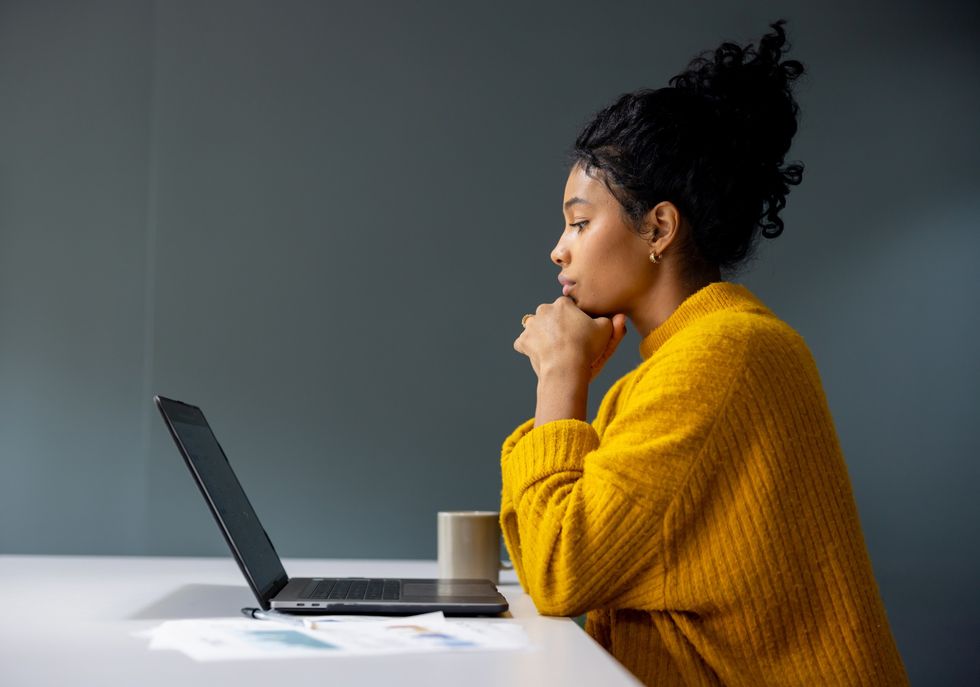
Getty Images
So, after reading all of this, you definitely sense that you or someone you know has some postpartum depression going on. What should you do? The first thing is what I’ve already mentioned, which is to make an appointment to see your doctor or midwife. Please don’t try, and “Google your way” into a remedy or solution because a medical professional may need to do lab work and mental health screenings to get to the root of what could be causing it. Next, if you are officially diagnosed, get a solid support system around you.
Remember (and it really can’t be said enough), postpartum depression is NOTHING to be embarrassed about or ashamed of. You had a baby, which is a supernatural feat; it may take some time to recover from all that came with doing that — and that is okay. Next, you might want to consider getting a postpartum therapist — and yes, there is such a thing. They can help you to better articulate your feelings and needs, offer proven tips to get you through this particular season, and help you to find therapy treatments that will be most effective for you personally.
All-Natural Remedies for Postpartum Depression
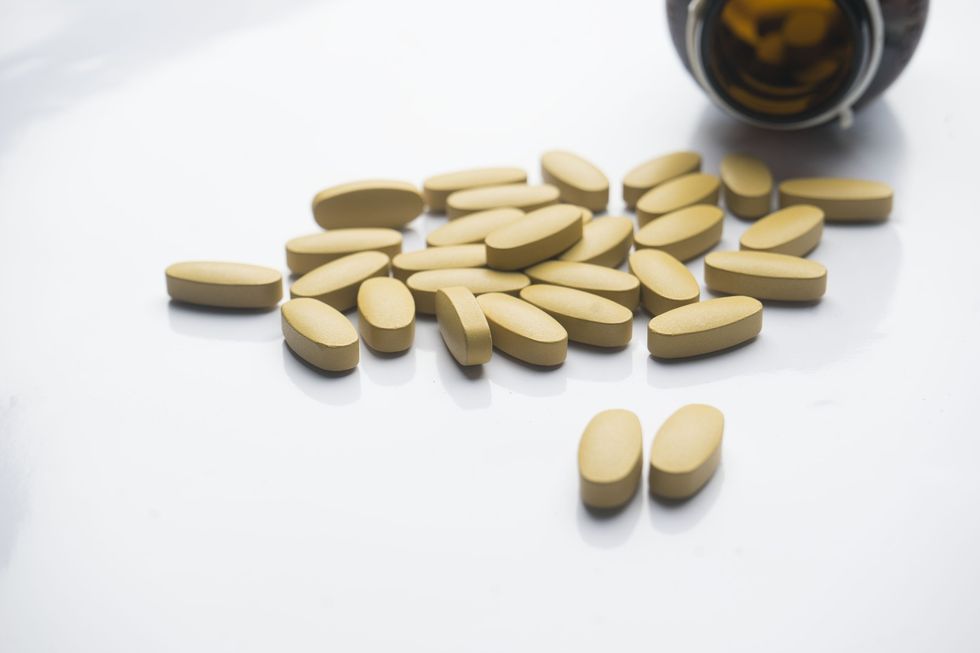
Getty Images
Please hear me loud and clear when I say that natural remedies for postpartum depression need to be accompanied by a physician’s (or midwife’s) knowledge and care.
The reason why I can’t stress that enough is, again, postpartum depression is nothing to be flippant with or about, and simply thinking that you can take a supplement and call it a day is irresponsible at best. At the same time, though, there are things that can complement whatever your doctor or midwife suggests as you’re on the road to healing from it.
1. Postpartum depression remedies: Get some omega-3s into your system.
Omega-3 fatty acids help to keep your cell membranes in peak condition, and yes, they have been proven to help reduce some of the symptoms that are associated with (postpartum) depression. In fact, some doctors recommend consuming these types of fatty acids throughout your pregnancy in order to reduce the chances of being diagnosed with postpartum depression. There are supplements that are available, and foods like flaxseeds, chia seeds, walnuts, meat from grass-fed animals, and salmon are filled with this particular nutrient, too.
2. Postpartum depression remedies: Consider some postpartum yoga.
Remember how Halle Bailey basically said that she felt disconnected from her body? Something that can help you to “reconnect” is postpartum yoga. Since it’s a form of exercise that decreases stress and anxiety, it’s low-impact, and it can help you to feel better about your body again — all of this works together to get you through postpartum depression.
3. Postpartum depression remedies: Fast from sugar, caffeine, and alcohol.
Sugar, caffeine, and alcohol are all stimulants — the kind that can make you feel energized and then cause you to crash a few hours later. When you have postpartum depression, you’re already on an emotional roller coaster ride, so you need to consume these things in extreme moderation.
Sugar? Studies say that it can actually make depression-related symptoms worse. Caffeine is a bit of a mixed bag; however, if it made you anxious before getting pregnant, you definitely should speak with your doctor before consuming it after pregnancy. Alcohol? It also increases your depression symptoms; plus, it’s potentially addictive.
4. Postpartum depression remedies: Get yourself an accountability partner.
Suffering in silence. A lot of new moms do it, which is why I was so glad that Halle spoke up about what she has currently been going through. When I say that you need an accountability partner (preferably a non-relative if you've got bossy or controlling ones who want to tell you "how things are done"), what I mean is you need someone who will help you to stick to your plans/goals for healing from postpartum depression, while supporting and encouraging you on your low days; you also need someone who will be great at helping you to feel good about yourself again.
Postpartum depression isn’t really something that you can get through (well) alone. Please don’t try to.
5. Postpartum depression remedies: Ramp up the self-care.
LISTEN, if there is ever a time when you shouldn’t feel the least bit guilty about getting (extra) massages, facials, or whatever else makes you feel pampered and beautiful — right after having a baby would be it. In fact, if you are currently pregnant, I recommend that you create a “pamper me budget” for your postnatal care. Why? Well, sometimes, one of the hardest things about adjusting to the new normal of a baby is trying to find the balance between prioritizing them vs. yourself.
When it comes to this final point, you’ve got to always remember that the healthier you are — mind, body, and spirit — the better off your baby will be, and that means that you’ve got to take premium care of your mental health…and yes, self-care via pampering plays a big role in that (check out “5 Reasons You Should Unapologetically Pamper Yourself”).
Why You Should Consider Hiring a Postpartum Doula
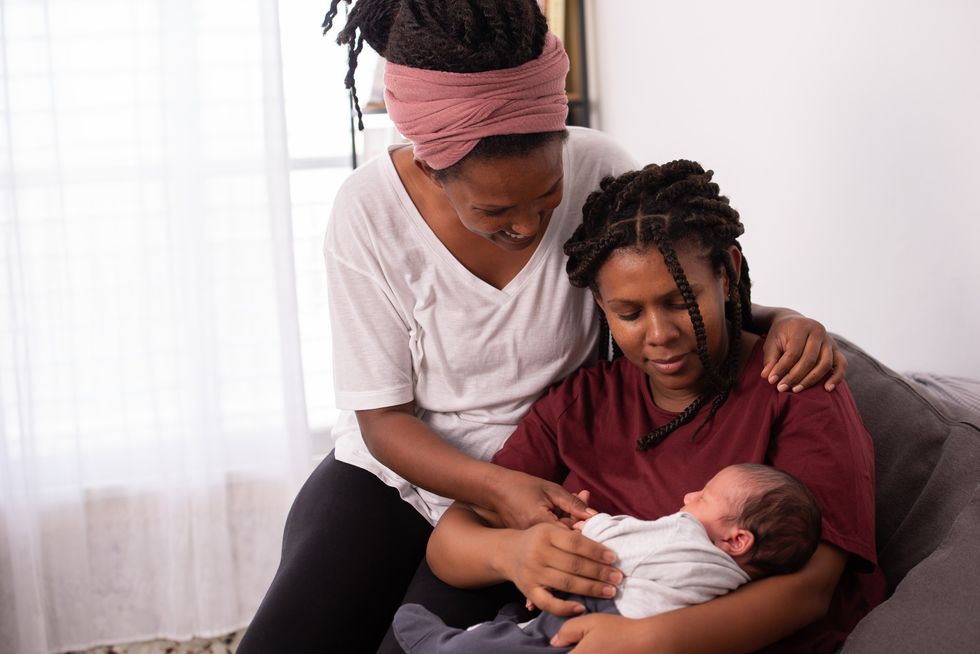
Getty Images
The way that my particular doula services work is I come into the pregnant mom’s life during the beginning of her third trimester and then stick around for a month following her giving birth to her child. That way, I can monitor any potential signs of postpartum depression, give her partner a break (yes, fathers have needs that shouldn’t be ignored during that time, too), and I can help around the house if the mom is too tired or physically not up to doing things like washing dishes or even changing her baby sometimes.
Although I do this naturally, the technical term for this type of doula is a postpartum doula. And even though we're all given information on how to provide postpartum care during “doula school,” a postpartum doula’s training is focused especially on how to support moms and babies after mom gives birth.
This can include doing all of the things that I already mentioned, as well as offering breastfeeding assistance (because it can sometimes take a minute to figure it out, trust me), running errands, preparing meals, helping out with other members of the family (like the other children) — some postpartum doulas will even spend the night a few nights a week so that the mom can get some quality rest.
Indeed, one of my favorite things about a postpartum doula is that while a baby nurse mostly only focuses on the newborn’s needs, a postpartum doula helps the entire family. Yeah, they are pretty bomb and can be a real godsend on a billion different levels. For information on how to find a doula or postpartum doula, click here. For information on how to become a DONA-certified doula, click here.
____
This one was lengthy (even for me — LOL), yet I hope you can see why it needed to be.
Halle, thanks again for bringing this issue to light. I salute you.
Having a baby is miraculous. New moms deserve all of the support that they need once they do it.
Let’s make things inbox official! Sign up for the xoNecole newsletter for love, wellness, career, and exclusive content delivered straight to your inbox.
Featured image by
This Is How To Keep 'Holiday Season Stress' From Infecting Your Relationship
Hmph. Maybe it’s just me, but it seems like there is something really weird happening in the fall season air (because winter doesn’t officially begin until December 21) that cuddle season is in full swing while break-up season is as well. In fact, did you know that break-ups are so popular during the holiday season that December 11 is deemed Break-Up Day?
The reasons why relationships shift around this time vary; however, I did both roll my eyes and chuckle when I read that a very popular one is because it’s an easy way to get out of getting one’s significant other a Christmas present. SMDH.
Anyway, I personally think that the less shallow folks out here may contemplate calling things “quits” or they at least distance themselves a bit from their partner (and what I’m referring to is serious relationships) due to all of the stress and strain that oftentimes comes with the holidays whether it be financial, familial, due to their tight schedules or something else.
Listen, I would hate for you and your man to miss the fun and happiness of experiencing this time of year, all because you are so overwhelmed or irritated that you can’t really enjoy it. That’s why I have a few practical tips for how to avoid allowing the typical holiday season stress from INFECTING your relationship.
Manage Your Expectations
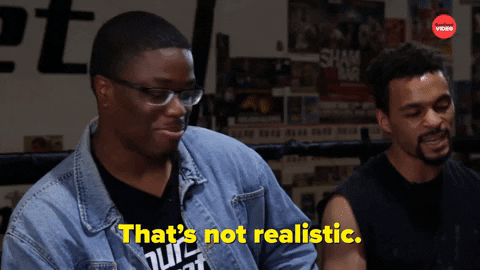 Giphy
GiphyUnmanaged expectations. If there is a main reason why the holiday season tends to be so stress-filled for so many people, I’d bet good money that this is the cause. And when you’re in a long-term relationship, expectations can manifest themselves in all sorts of cryptic and/or unexpected ways. You might have relatives who assume that you are going to be with them for Thanksgiving or Christmas when you have other plans in mind. You might be thinking that you are going to spend one amount for presents while your man is thinking something totally different. When it comes to scheduling, your signals may be crossed.
And you know what? To all of these scenarios, this is where clear and consistent communication come in. Don’t assume anything. Don’t dictate anything either. From now until New Year’s, mutually decide to check in once a week, just to make sure that you are both on the same page as it relates to the holidays and what you both are thinking will come along with it. The less blindsided you both feel, the less stressed out you will be. Trust me on this.
Set (and Keep) a Budget
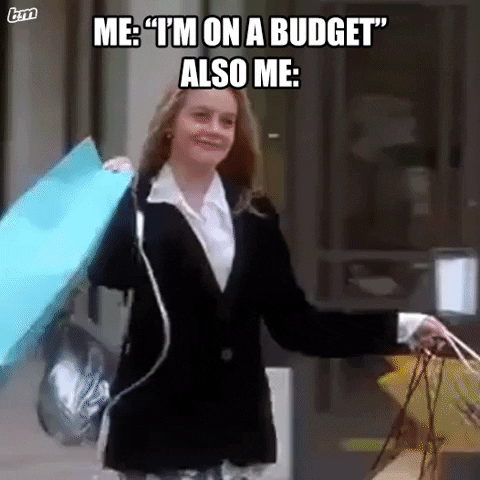 Giphy
GiphyOkay, so I read that last year, 36 percent of Americans incurred some type of holiday-related debt. Hmph. Last year, there was still some sense of normalcy in this country, chile, so I can only imagine what finances are gonna look like over the next several weeks. That said, since I don’t know a lot of people who don’t find being broke stressful, make sure that you and your bae set a budget and then stick to it this year — no ifs, ands or buts.
Because really, y’all — it doesn’t make sense to deplete savings and/or max out credit cards for a few days of giggles only to be damn near losing your mind because you don’t know how to make ends meet come Dr. Martin Luther King, Jr. Day.
And by the way, this tip doesn’t just speak to things like food and gifts; I also mean travel. If it doesn’t make a ton of sense (or cents) to be all over the place this year — DON’T BE.
Keep Matthew 5:37 at the Forefront
 Giphy
GiphyIf off the top of your head, you don’t know what Matthew 5:37 says, no worries, here ya go: “But let your ‘Yes’ be ‘Yes,’ and your ‘No,’ ‘No.’ For whatever is more than these is from the evil one.” That verse right there? Oh, it’s a boundaries lifesaver! I say that because do you see “maybe” or “I’ll think about it” in there? Nope. LOL. It says that you should tell people “yes” or “no” and leave it at that — and that complements Anne Lamott’s quote, “’No’ is a complete sentence” impeccably well. Yeah, you’ve got to remember that anything beyond a yes or no to a request is privileged information; you don’t owe anyone details or an explanation.
Besides, if you are really honest with yourself, when someone asks you something and you give a “Umm, let me think about it” kind of reply, more times than not, you already know what your answer is going to be — so why not let you both off of the hook? Give your response. Commit to that. And let everyone (including yourself) get on with their lives and schedules.
I promise you that when it comes to those holiday parties, you are pissing more folks off by not RSVP’ing or doing so and not showing up than just saying, “Thank you but not this year” off the rip.
Remember That Your Personal Space Is Privilege Not a Right
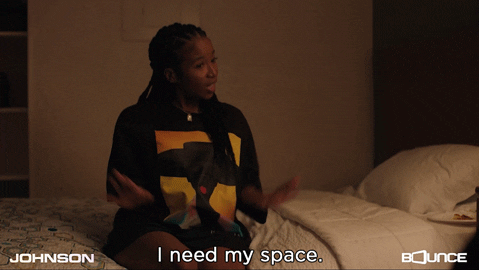 Giphy
GiphyA friend of mine recently bought a new house and invited me over to come see it. He’s a single man with no children, so as I was taking in all of the space that he had, especially as I walked through his finished basement, I joked about relatives coming to live with him. “Hell no” and “absolutely not” were pretty much his immediate responses as he went on to say that some folks even had the nerve to be offended when he told them that he had no intentions on taking DNA in.
Ain’t it wild how people think that your stuff is their right? And yes, that brings me to my next point. Your home is your sanctuary space. If you want to host folks this year — cool. If not, ALSO COOL. Please don’t let folks (family included) guilt you into how they want you to act or even into what they would do if the shoe was on the other foot. You are not them — and as one of my favorite quotes states, “If two people were exactly alike, one of them would be unnecessary.” (A man by the name Larry Dixon said that.)
Hell, my friends? They know that I am good for sending them random things that they need or even want all throughout the year. Coming over to hang out at my pace, though. Uh-uh. Chalk it up to being a card-carrying member of the ambivert club yet I like keeping my living space personal — and I sleep like a baby, each and every night, for feeling that way.
Always remember that your space, your time, your resources, your energy and shoot, yourself period (including your relationship), are all things that are your own. You get to choose how, when and why you want to share them. The holiday season is certainly no exception.
Cultivate Some “You Two Only” Traditions
 Giphy
GiphyIt’s not uncommon for some couples to hit me up after the holiday season to “detox.” Sometimes it’s due to the financial drama (and sometimes trauma) that they experienced. Sometimes it’s because they allowed their relatives (especially in-laws) to get more into their personal business than they should’ve. More than anything, though, it tends to be because they didn’t get enough quality time together and so ended up feeling “disconnected.”
Please don’t let that happen. Listen, I’m not even a holidays kind of woman and yet, I will absolutely sit myself down with some hot chocolate and chocolate chip cookies to enjoy a Hallmark holiday film or two. Aside from the fact that most of them are lighthearted and sweet, I also like that they usually focus on couples loving on each other amidst all of the holiday beauty and ambiance — which is something that all couples should set aside some time to do.
Maybe it’s a vacation. Maybe it’s a staycation. Or maybe it’s my personal favorite, A SEXCATION. Whether it’s for a few days, the weekend or even overnight — don’t you let the holidays go by without setting aside time for you and your man to celebrate one another. Don’t you dare (check out “Are You Ready To Have Some Very Merry 'Christmas Sex'?”).
GET. SOME. REST.
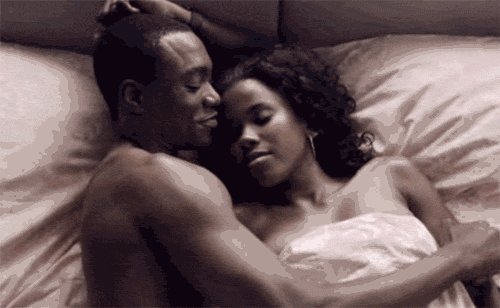 Giphy
GiphyI once read that 8 out of 10 people get stressed out over the holidays and 3 out of 10 lose sleep during to it — and when you’re stress-filled and sleep-deprived, that can absolutely lead to hypersensitivity, making mountains out of molehills and even not being in the mood for sex.
Your relationship can’t afford to go through any of this, so definitely make sure to prioritize rest. I don’t care how unrealistic it might seem during this time, sleep should never be seen as a luxury; it will always and forever be a great necessity.
That said, try to get no less than six hours of shut-eye in (check out “6 Fascinating Ways Sex And Sleep Definitely Go Hand In Hand”) and even ask your bae to take a nap with you sometimes (check out “Wanna Have Some Next-Level Sex? Take A Nap, Sis.”). Not only will sleep help to restore your mind, body and spirit but, when it’s with your partner, it’s an act of intimacy that can make you both feel super connected, even in the midst of what might feel like chaos.
___
Holiday season stress is real. Still, never give it the permission or power to throw your relationship off. Put you and your man first and let the holidays be what they are gonna be, chile.
Let’s make things inbox official! Sign up for the xoNecole newsletter for love, wellness, career, and exclusive content delivered straight to your inbox.
Featured image by Shutterstock
How To Avoid Being An Emotionally Impulsive Spender This Holiday Season
Geeze. Can you believe that we are just a few days out from another Christmas? Yeah, me neither. In fact, because I’m not a holidays person myself (check out “So, What If You Don't Observe Holidays?”), it wasn’t until one of my clients was venting about how stressed out she was due to all of the holiday season procrastinating that she had been doing that I realized just how fast December is actually flying by.
If, like her, you’re feeling frazzled because, although you told yourself last year that you weren’t going to wait until the last minute to “handle your business,” you ended up doing exactly that, fret not. I’ve got 10 tips that can keep you from making emotionally-triggered decisions as far as your financial expenses are concerned. Merry Christmas. #wink
1. Create a Budget. Stick to It.
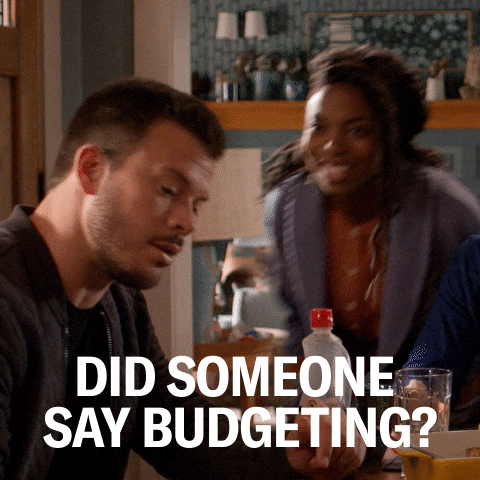 Giphy
GiphyBudgets, boy. I recently read that one of the reasons why they don’t work for a lot of people is because many folks don’t have a clue about how much money they spend on a monthly basis to begin with. SMDH. That said, at the end of the day, it’s important to remember that a budget is simply setting boundaries/limits on your spending — and being intentional about moving in this fashion is always a wise move; especially when it comes to this time of the year…especially being that it’s typical for half of all Americans to take on some type of holiday season debt with 17 percent needing six (or more) months to pay it off.
Know what can prevent this kind of financial chaos? A SPENDING BUDGET. Tips for how to create one of your own this year can be found here.
2. Never Shop When You’re Stressed or Pressed
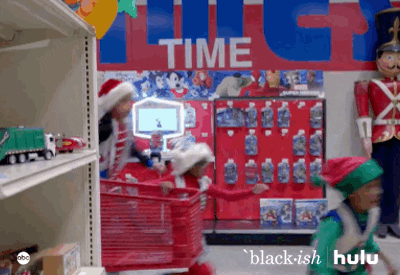 Giphy
GiphyYou know how they say that it’s not a good idea to go grocery shopping when you’re hungry? Although the holiday season can be a stressful time, avoid shopping for gifts (or décor or food for recipes) when you are feeling stressed out or pressed for time. More times than not, that cultivates anxiety which could cause you to either purchase things that you don’t really want or to spend money that you don’t really have (P.S. If you’re relying on credit cards, that qualifies as money that you don’t really have. Just sayin’).
3. Don’t Keep Up with the Joneses
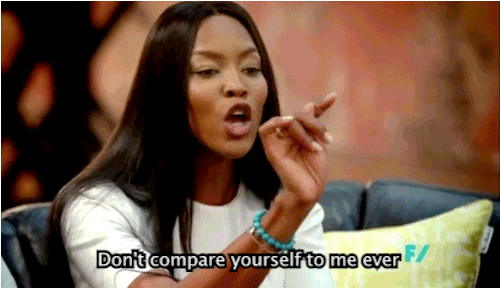 Giphy
GiphyKnow something else that can stress you out: trying to keep up with the Joneses. And y’all, now that we have social media, the reality is that envy is at an all-time high. That’s because it can be really easy to watch holiday engagements, holiday trips and folks bragging about the things that they’ve received in times past, only for you to find yourself wishing that you were them — or putting pressure on yourself and those in your world to keep up.
Listen, it is King Solomon who once said, “So are the ways of everyone who is greedy for gain; It takes away the life of its owners” (Proverbs 1:19 — NKJV) and “A sound heart is life to the body, but envy is rottenness to the bones” (Proverbs 14:30 — NKJV) and he’s considered to be the wisest man who ever lived (during his time — I Kings 4:30). Yeah, both of these verses are a spiritual reminder that whatever you are planning to do or give, do it out of the goodness of your heart — not so that you can low-key “outdo” the next guy.
4. No Need to “Tit-for-Tat”
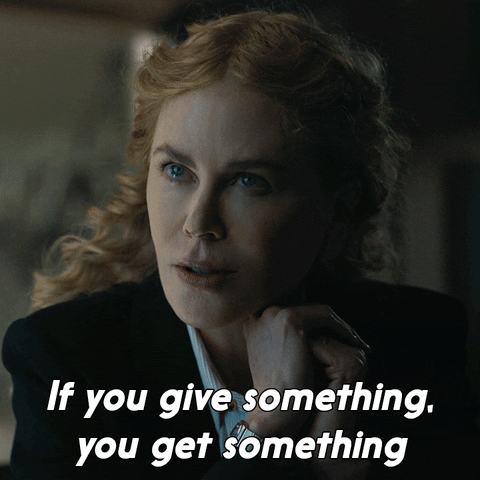 Giphy
GiphyThis one might be a bit controversial yet I’m totally okay with that. I don’t care what the occasion is, no one is OWED a present. A gift is a voluntary token of one’s appreciation or affection. That said, if you decide to give someone a present this year, don’t automatically expect something in return. If you get something, cool. If not, if you were giving for the right reasons, it really shouldn’t matter (RIGHT?). On the flip side, if someone decides to get you something and you don’t have something to offer in return, also cool.
Other than going to someone’s home for a holiday dinner or party, for anyone to feel like they should have something in hand because someone else does…that’s not giving, that’s competing — and that absolutely should not be the spirit that you are in (or around) during this time of year.
Again, a gift is not an obligatory thing. If you’ve always thought otherwise, it’s time to do some serious reprogramming.
5. Avoid the Pressure to Buy for Lots of Adults
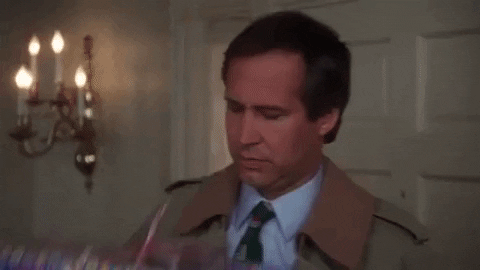 Giphy
GiphyLast month, Newsweek published an article that said it’s wise to not spend a ton of money purchasing gifts for adults. A financial expert in the piece said that it’s best to buy for kids because, more times than not, you’re going to get adults something that they already have a lot of, they don’t really need or they’re not going to use (beyond maybe regifting) anyway.
If you’re not feeling that insight, my take would be to exchange names and set a price cap for the grown folks. I say that because, I don’t think that people ever outgrow wanting something over Christmas. It’s just that the over-the-top energy should be reserved for the kiddies — and even then, the “4-gift rule” (want, need, read, experience) is probably your best bet for them…financially and otherwise.
6. Go for Thoughtful over Expensive
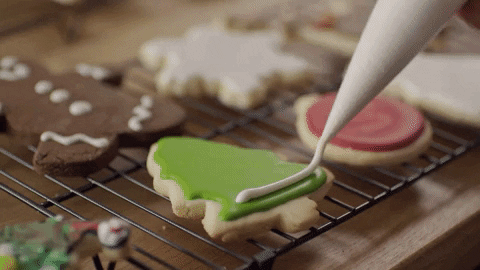 Giphy
GiphyIt’s kind of wild how much close-to-torture folks send themselves through to purchase gifts that, a good 6-8 months now, most folks aren’t even going to remember. That’s why it’s also a good idea to purpose in your mind to get something thoughtful over expensive.
Honestly, that’s a big part of the reason why Etsy continues to be a go-to for gifts (for every occasion) for me. It’s because you can oftentimes get things customized/personalized which ends up meaning so much more to people than something that you bought at a generic department store that might have a high price tag yet still lacks in sentimentality and deep meaning.
7. Use Coupons and Promo Codes
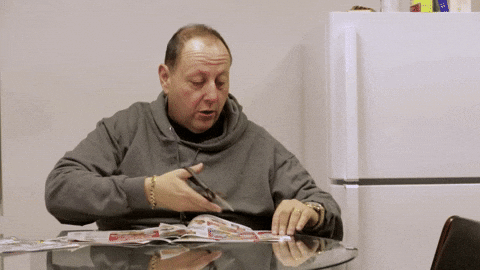 Giphy
GiphyCoupons (and promo codes) are a slippery slope in the sense that…they remind me of when I used to go overboard while thrift store shopping. I say that because, just because I might find several bomb dresses for under $20, what am I going to do with 50 of ‘em (over time)? It’s just as much of a waste of money as buying couture if neither option gets much use.
And that’s kind of the thing about coupons and promo codes. Some people end up overspending because they rationalize that so long as there are discounts attached, it’s all good. At the same time, this doesn’t mean that you should forego coupons and promo codes altogether. The key is to put together your shopping list (and budget) and then use discounts specifically for those items. If you do this, you could save well over $1,000 annually (at least, depending on what you decide to buy).
8. Avoid Add-Ons
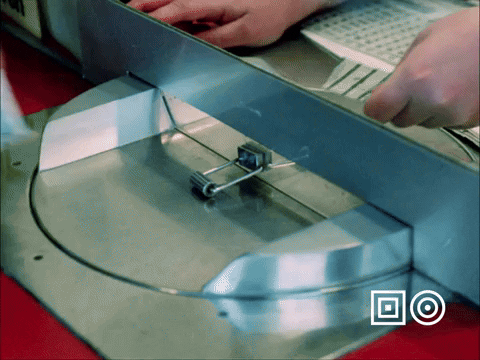 Giphy
GiphyYeah. Dodge add-on expenses. Add-ons like what? The first thing that comes to my mind is a warranty. What’s the chance that someone is actually going to need that? Another example is paying for things to be “professionally” gift wrapped. Chile, throw that stuff in a gift bag with some tissue paper and go on about your day. All good.
9. Rethink Gift Cards
 Giphy
GiphyIf there is any time of the year when there is a noticeable hike in gift card purchases, now would be it. And although they are a convenient approach to gift giving, at the same time, many come with hidden fees, the full amount oftentimes goes unused (which ends up being a waste of money) and they do come with expiration dates that are oftentimes forgotten.
So, if you’re someone who likes to wait until the last minute to do your holiday shopping, resist the urge to impulsively pick up a handful of gift cards. Unless it’s to a place that you know someone is going to use within the next few months, they could end up in somebody’s kitchen drawer for the next couple of years. And what a waste that would be.
10. They’ll Get It When They Do. And That’s Okay.
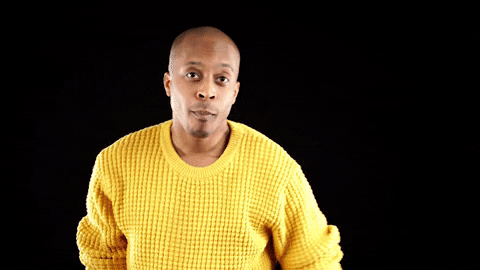
=
GiphyOne more. Although it is super thoughtful and proactive to get people their gifts in time for whatever occasion you purchased them for, if trying to reach that goal is going to require paying for rush shipping that is damn near as high as the price of gift or spending a lot of gas money that you don’t have at the moment to drive miles and miles away — take the pressure off to spend a ton of cash just to make sure that something arrives at December 25. Listen, through doing business with Etsy, I have learned that through this administration, there are all sorts of tariff issues going on and the USPS is slower than ever too, so paying more may not guarantee much.
The hack? Send a message that something special is coming…soon enough. The thought really is what counts (more times than not); plus, it builds anticipation of something good coming, even if it’s after all of the Christmas Day hoopla. And no one (with sense) is going to have a problem with that.
Now don’t you feel better? Happy Holiday Shopping, sis.
Let’s make things inbox official! Sign up for the xoNecole newsletter for love, wellness, career, and exclusive content delivered straight to your inbox.
Featured image by Shutterstock

